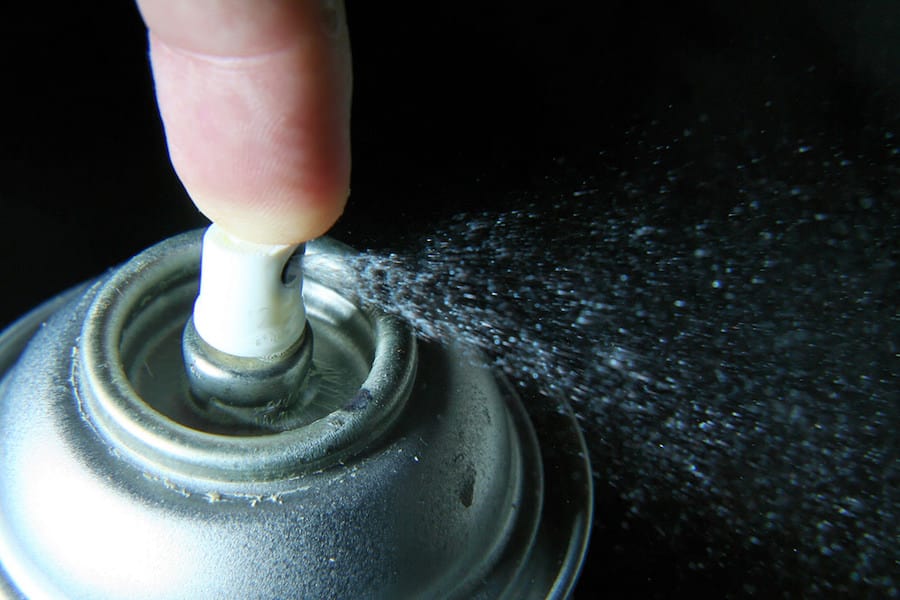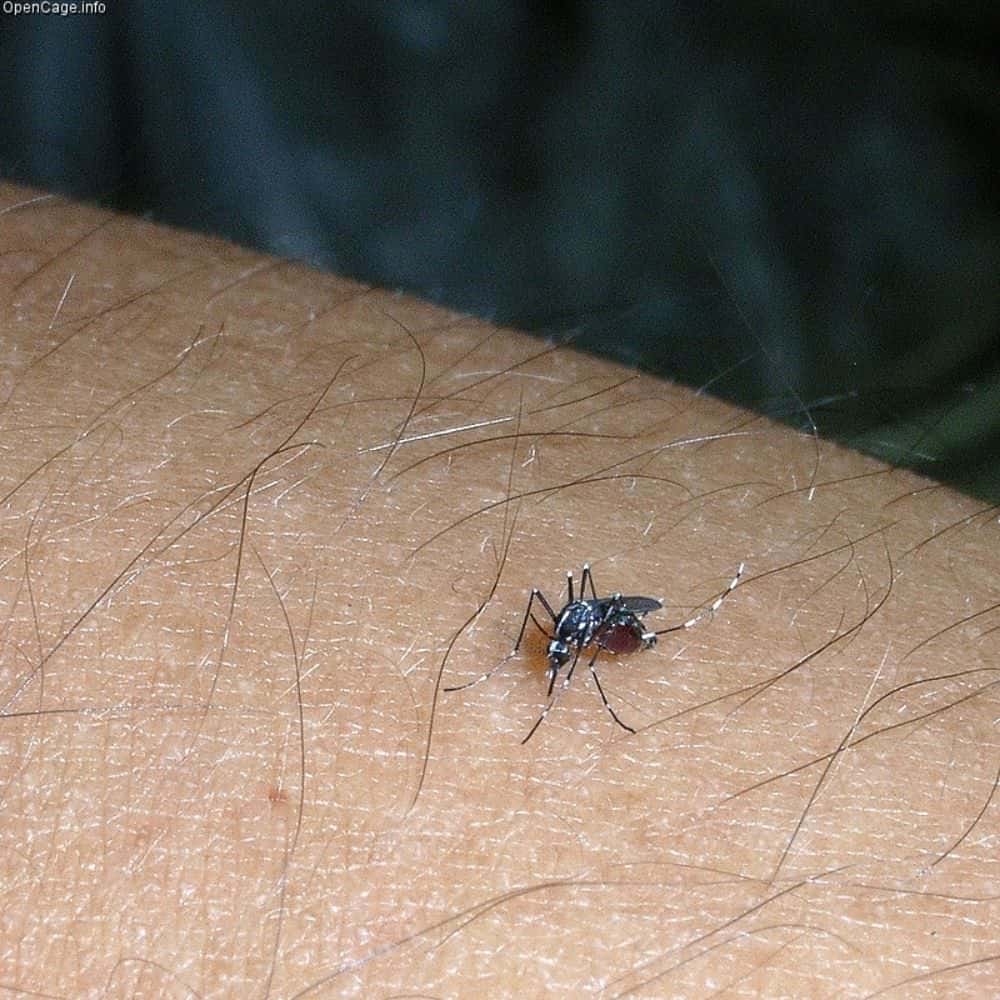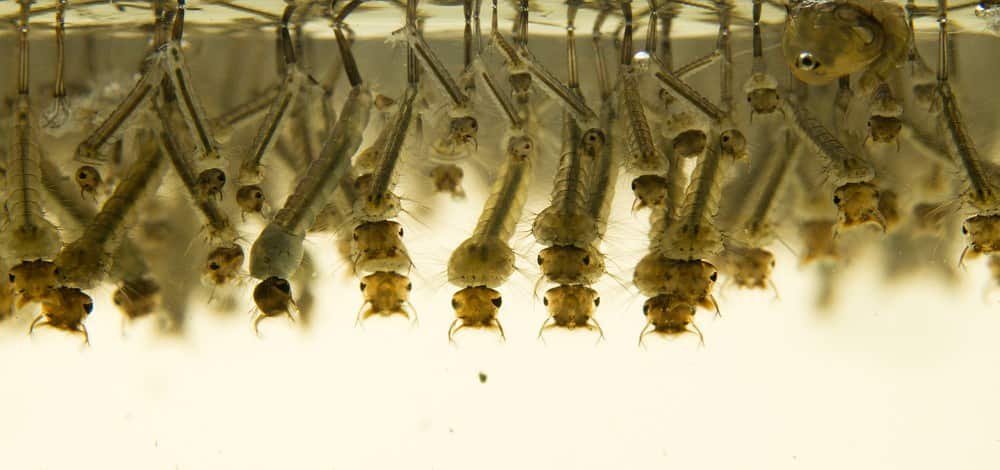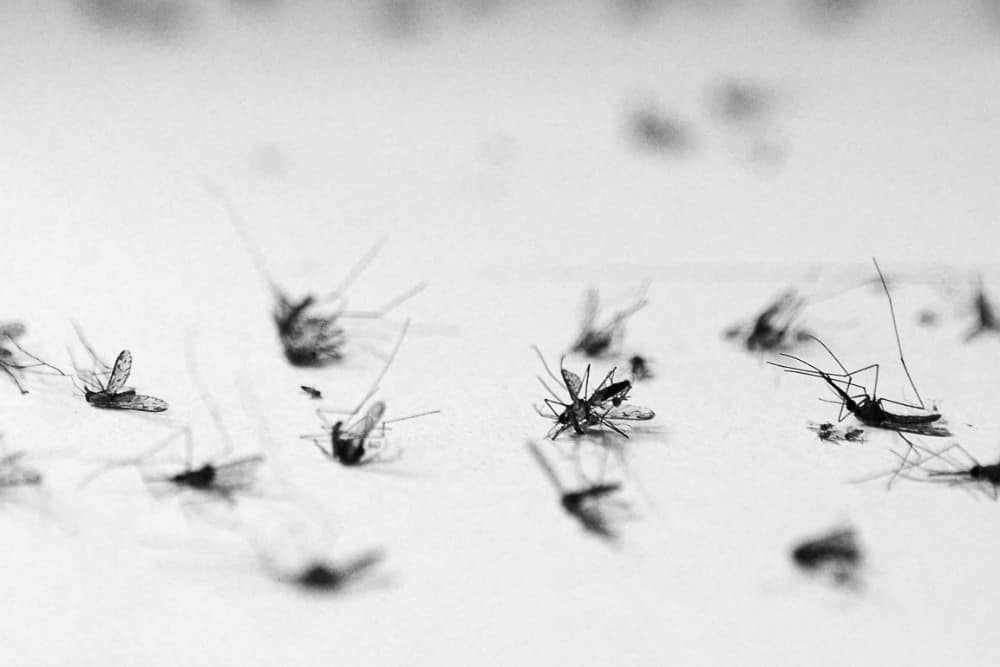Mosquito Eaters
Due to the many diseases that mosquitoes can carry, experts are constantly trying to find different ways to control their numbers. Can the mosquito eater help with this?
Many people have never heard of this mysterious animal. When we hear the name, we might be reminded of an anteater. This is a small tropical animal with a long snout that sucks up ants from their homes in the ground.
But don’t be confused. A mosquito eater is something completely different.
What Is a Mosquito Eater?
A mosquito eater is a large flying insect, more commonly known as the crane fly. These bugs are part of the Taxonomic insect order, meaning that they are an evolutionary species.
Crane flies are from the Tipulidae family within the Diptera order, more specifically in the class called Insecta. The Tipulidae family consists of over 200,000 insect species. Of these, the mosquito eater has approximately 14,000 different varieties.
We can expect to find the crane fly mostly in tropical climates, but it is also quite commonly found in the U.S.
Most of the mosquito eater species thrive near woodlands, where there is easy access to water. There is, however, another variety which has accustomed itself to living next to more open plains, closer to populated areas.
Life Cycle
The crane fly resembles the mosquito in many ways. In addition to a physical resemblance, it goes through similar life stages. The female crane fly will leave her eggs to hatch in areas where the soil remains wet. Some species will seek out small ponds or rivers.
The female crane fly does not have a long lifespan, at most a week or two. She lays her eggs and flies off to mate yet again.
The eggs will lay in the soil or water for about a week before they are ready to hatch. As the larvae rise from the eggs, they will quickly seek shelter near vegetation.
Experts generally refer to crane fly larvae as leatherjackets. This is due to the fact that their covering gives them a rugged appearance. Leatherjackets have a worm-like appearance, with long slender bodies covered with fine hair.
While some crane fly larvae thrive under the water’s surface, most varieties prefer the terrestrial landscape. These land lovers hide under the top layer of soil during the night, and feed during the daytime.
In the agricultural sector, farmers consider crane flies to be harmful pests, due to their destructive nature toward crops. They feed mainly on the stalks and roots, and use their fur to suck nutrients directly from the crops. This then directly compromises the quality of the produce.
They can feed on decaying plants or fungi, but also enjoy eating roots or turf grass which often causes damage to our plants and lawns. The larvae will continue feeding on whatever they find near until they reach the pupae stage.
The crane fly larvae, like the mosquito, will generally hibernate during the colder seasons. When spring melts the frozen ground, the pupa phase goes into action and the larva will build a cocoon around itself. Inside, it undergoes metamorphosis, where it will soon transform from larva to become an adult.
The pupa itself looks similar to the larva. It resembles a worm, with small sections across its back. The cocoon is usually brown in color with a hard shell, almost resembling a little cockroach.
During this stage, the crane fly pupa is in a non-feeding phase. However, like mosquito pupa, it can use its body to wiggle away from possible danger, whether in the water or on land. By the time the hot summer months roll around, the pupa has evolved and will enter the world as an adult crane fly.
What Do Mosquito Eaters Look Like?
Mosquito eaters, or crane flies, actually look like giant versions of mosquitoes. They have a long, slender body. While similar in shape, their legs are longer and wider as well. Some species can reach a size of three inches long.
The mosquito eaters appear a bit odd in their shape, especially with their long body and legs. Because of this, they often appear unsteady and wobbly while they are flying.
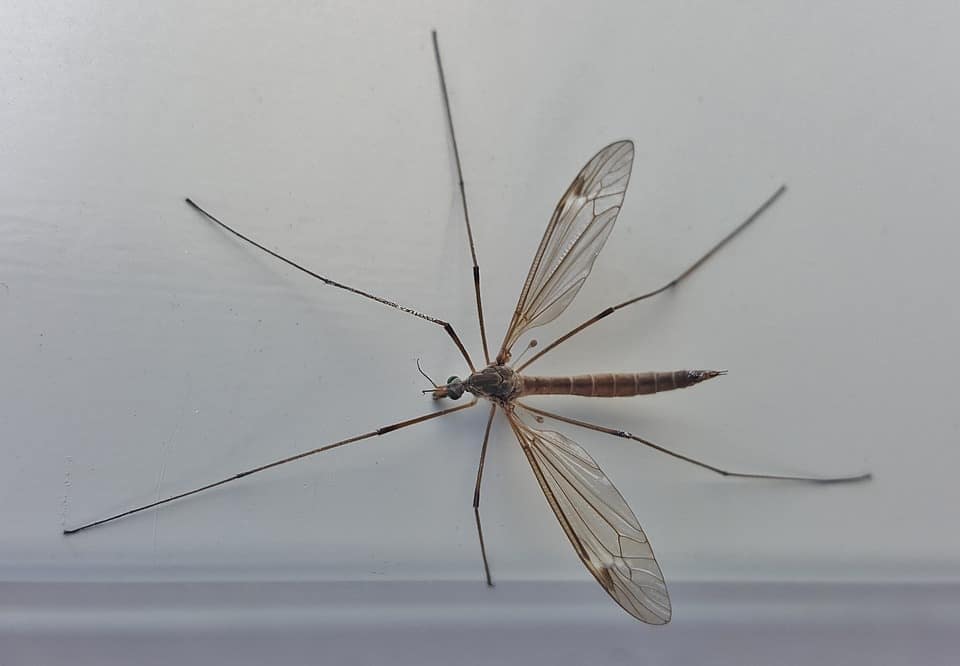
Sometimes, however, this is intentional. Male mosquito eaters usually fly in zig-zag patterns as a way of attracting females. The females, on the other hand, generally travel in a straight line, or at least they try to.
For those who aren’t lovers of flying insects, crane flies can be startling to encounter. This is not only due to their size and the way they fly, but also to the incredible sound they make.
The buzz of the crane fly resembles a sound which might come from a giant housefly. It is so loud that you can easily hear it from across the room.
Female crane flies look a little different to the males. Often larger in size, they also have something called an ovipositor at the end of their long body, which resembles a v-shape. This is where the eggs exit her abdomen. Males do not have this v-shaped organ.
The adult crane fly is generally brown in color. As light shines on its long slender body, a green—almost bluish—hue enhances its features.
Leatherjackets, or crane fly larvae, resemble worm-like creatures. Often grey and fat, some species can appear brown or even green. Other varieties are translucent, to the point where internal organs are visible.
The small hairs, or tentacles, on the outside of the skin can extend if the larva senses danger. This could be, for example, if someone were to move close to it or try to catch it.
Just like the adults, crane fly larvae are quite large. While mosquito larvae can be unnoticeable, some species of crane fly larvae could measure up to 1.5 inches.
Do Mosquito Eaters Actually Eat Mosquitoes?
In case you imagined a big beast, hovering over mosquitoes and sucking them up on sight, I’m sorry to disappoint you.
Mosquito eaters, or crane flies, don’t actually eat mosquitoes. In fact, some species don’t eat at all during their adult life, because they don’t have a mouth to feed with.
Those species which do have a mouth tend to feast on flower nectar, similar to male mosquitoes.
Crane flies are a bit of an odd insect species. They generally don’t mean any harm, either to humans, mosquitoes or any other bugs. Their sole purpose in life is to reproduce. As soon as the adult emerges from its cocoon, whether male or female, it heads straight out into the mating game.
So, if you were hoping that the mosquito eater would be the answer to your pest infestation, I’m afraid you’re in for a disappointment. Crane flies are incapable of killing a mosquito.
So Why Are They Called Mosquito Eaters?
The answer is not straightforward at all. In fact, even the experts aren’t entirely sure. Some want to argue that it’s because of their giant mosquito shape, while others believe it is due to the feeding habits of the crane fly larvae.
Crane fly larvae tend to eat pretty much anything around them. As they are typically living in the same damp conditions as mosquito larvae, if they encounter such larvae in their vicinity, they will feed on it.
What Other Insects Eat Mosquitoes?
So, if the mosquito eater doesn’t have mosquitoes on his menu, what does, you ask?
Due to their tiny size, mosquitoes are actually the main component of many predators’ diet. These predators who enjoy snacking on the vampire-like pest play a role in nature’s mosquito control.
Here is a list of the creatures who actually do eat mosquitos. And as we have established, mosquito eaters aren’t going to be among the animals below.
Gambusia Affinis
Gambusia Affinis, otherwise known as the mosquitofish, are tiny fish, which can be found scattered across the U.S. Their main purpose is to feed on mosquito larvae.
These little fish are probably some of the best natural mosquito killers we have available. They helped to partially eliminate malaria mosquitoes from the States a few decades back. They were later introduced to the state of Hawaii to help control the mosquito population there.
Specialists have carried out research to see how much they will eat. Despite the small size of 2.5 inches for the average female 1.5 inches for the male, the results were astonishing. The mosquitofish is capable of consuming between 42 percent and a staggering 167 percent of its total body weight.
Purple Martins
Purple Martins are not the biggest threat to mosquitoes. They do consume a few here and there. By the time mosquitoes emerge from their hiding spots, however, these birds are usually way above insect territory.
The Purple Martin will generally feed on larger bugs, such as moths, butterflies, wasps, bees and even June bugs. Mosquitoes, on the other hand, make up less than three percent of their diet.
Nonetheless, these birds might help to keep a few mosquitoes away from your BBQ party.
Bats
While we do consider bats a natural predator for mosquitoes, these night hunters are opportunistic feeders. This means that a bat will consume anything which flies in front of its nose.
However, bats are more reliable mosquito eaters than the Purple Martin, mentioned above. They generally fly out at night when mosquitoes are most active. Not only that, but they also hunt near ground level, where mosquitoes can often be found.
Many like to refer to bats as voracious mosquito hunters. It’s interesting to note, however, that mosquitoes actually only make up about one percent of their diet. They actually prefer other insects, such as beetles, wasps, and moths.
Dragonflies
The dragonfly’s nickname of “mosquito hawk” indicates that it is another fly that mosquitoes should fear. They do indeed do consume a fair amount of mosquitoes. However, the dragonflies do not actually eat enough to have a significant impact on the mosquito population.
What is perhaps more relevant is that, during the dragonfly’s larval stage, it will consume an impressive amount of mosquito larvae.
Similar to the mosquitofish, dragonfly larvae work to eliminate mosquitoes before they have time to mature into adults. The larval phase of the dragonfly can last up to six years. Because of this, they have plenty of time to feed on, and reduce the population of, generation after generation of mosquito larvae.
Damselflies
Like the dragonfly, damselfly larvae also love to feed on their smaller neighbors. Though they aren’t nearly as active as the dragonfly above, they do provide some help.
The damselfly larvae, or naiads, as experts call them, are pretty vicious in the water. Due to their survival instincts, they feed on almost anything small enough to fit into their mouth. Not only are they marvelous to see, but they are also excellent at eradicating mosquitoes before they reach us and our vulnerable skin.
Frogs, Toads, and Tadpoles
This group of small hoppers thrive in mosquito territories — wetlands, swamps, and ponds.
Tadpoles are the young versions of frogs and toads. They grow and develop in the water, where they find mosquito larvae an easy meal. Generally, however, tadpoles prefer algae and other plants.
Frogs and toads, on the other hand, tend to feast on adult mosquitoes whenever the opportunity arises.
Unfortunately, this group also does not pose a significant threat to mosquitoes. But like the other creatures mentioned here, they do help to make a small dent in the vast mosquito population.
Summary
Despite looking and sounding like something which consumes mosquitoes for breakfast, the mosquito eater does not actually consume or kill mosquitoes. The so-called mosquito eater is, sadly, not what we’d hoped it would be when seeking ways to decrease the mosquito population. It is in fact, a gentle giant known as the crane fly.
There are other insects and animals which, while not eliminating mosquitoes, do a lot more than the misnamed mosquito eater.

